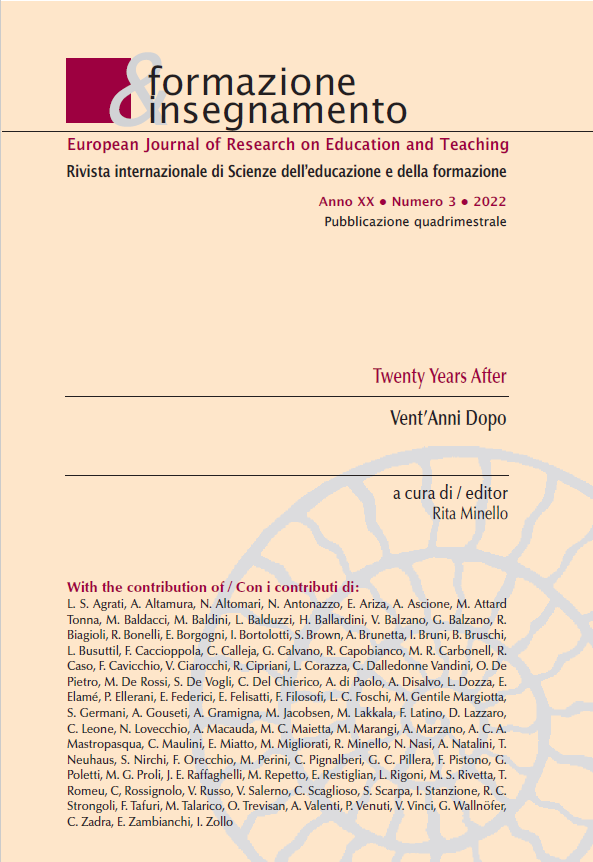The influence of stress and protective factors on teaching practices: A survey of teachers in training
DOI:
https://doi.org/10.7346/-fei-XX-03-22_44Keywords:
Teachers, Work-related stress, Stressors, Inclusive teaching practices, Pre-service teacher trainingAbstract
Work-Related Stress (WRS) in the teaching profession is a focal issue in the current scientific landscape. While the main causes and consequences in terms of teachers’ mental and physical health are known, contextual causes related to organization and effects on the implementation of effective teaching practices are neglected, thus tying psychological aspects to pedagogical implications. The paper shows the results of a research conducted on a sample of 139 teachers coming out of a TFA course on ICT, aimed at investigating the main factors of SLC and its implications for the activation of inclusive teaching. The results show that the major cause of stress is the relationship with colleagues who are perceived as unsupportive. In particular, the lack of recognition of the role of support teacher prevents the implementation and testing of inclusive practices, although these are part of the teacher’s skill set.
References
Annese, S., & Loperfido, F. F. (2016). La dimensione collaborativa tra partecipazione e apprendimento nella formazione degli insegnanti. Form@ re, 16(2). http://dx.doi.org/10.13128/formare-1820
Argentin, G. (2018). Gli insegnanti nella scuola italiana. Ricerche e prospettive di intervento. Il Mulino.
Ashforth, B. E., & Mael, F. (1989). Social identity theory and the organization. Academy of management review, 14(1), 20–39.
Avallone, F. (2021). Psicologia del lavoro e delle organizzazioni. Costruire e gestire relazioni nei contesti professionali e sociali. Carocci.
Baiocco, R., Crea, G., Laghi, F., & Provenzano, L. (2004). Il rischio psicosociale nelle professioni di aiuto. La sindrome del burnout negli operatori sociali, medici, infermieri, psicologi e religiosi. Erickson.
Baldacci, M. (2017). La “nuova” formazione dei docenti. In G. Domenici (Ed.), La formazione iniziale e in servizio degli insegnanti (pp. 322–326). Armando Editore.
Borgogni, L., & Consiglio, C. (2005). Job burnout: evoluzione di un costrutto. Giornale Italiano di Psicologia, 1, 23–57.
Braun, V., & Clarke, V. (2006). Using thematic analysis in psychology. Qualitative research in psychology, 3(2), 77–101. https://doi.org/10.1191/1478088706qp063oa
Brouwers, A., Tomic, W., and Boluijt, H. (2011). Job demands, job control, social support and self-efficacy beliefs as determinants of burnout among physical education teachers. Eur. J. Psychol. 7(1), 17–39. https://doi.org/10.5964/ejop.v7i1.103
Castelli, L., Crescentini, A., & Marcionetti, J. (2017). Lavorare a scuola. Condizioni di benessere per gli insegnanti. Locarno: Centro innovazione e ricerca sui sistemi educativi.
Chirico, F., & Ferrari, G. (2020). Il burnout nella scuola. Strumenti per la valutazione del rischio e la sorveglianza sanitaria. Edizioni FS.
Di Donato, D., Stanzione, I., Cecalupo, M., & Bortolotti, I. (2021). Digital training in the teaching profession and well-being at work: which elements and which relationships?. In ICERI2021 Proceedings (pp. 5481–5486). IATED.
European Social Partners (2004). European Framework Agreement on work-related Stress. UNICE, UEAPME, CEEP. Retrieved September 30, 2022, from http://erc-online.eu/wp-content/uploads/2014/04/2005-00679-EN.pdf
Eurydice (2021). Insegnanti in Europa: carriera, sviluppo professionale e benessere. Rapporto Eurydice. INDIRE – Unità italiana di Eurydice. Retrieved September 30, 2022, from https://eurydice.indire.it/wp-content/uploads/2022/04/QUADERNO_EURYDICE_51_insegnanti.pdf
Gale, N. K., Heath G., Cameron, E., Rashid, S., & Redwood, S. (2013). Using the framework method for the analysis of qualitative data in multi-disciplinary health research. BMC Medical Research Methodology, 13, 117. https://doi.org/10.1186/1471-2288-13-117
Gentile, M. (2015). La formazione in servizio: un modello a due livelli. Il caso del CESEDI di Torino. RICERCAZIONE, 7(2), 233–252. Retrieved September 30, 2022, from https://ricercazione.iprase.tn.it/issue/view/20/49
Guglielmi, D., & Fraccaroli, F. (2016). Stress a scuola: 12 interventi per insegnanti e dirigenti. Il Mulino.
INAIL (2017). La metodologia per la valutazione e gestione del rischio stress lavoro-correlato. Dipartimento di medicina, epidemiologia, igiene del lavoro e ambientale https://www.inail.it/cs/internet/docs/alg-pubbl-la-metodologia-per-la-valutazione-e-gestione_6443112509962.pdf
Lakkala, M., & Ilomäki, L. (2015). A case study of developing ICT-supported pedagogy through a collegial practice transfer process. Computers & Education, 90, 1–12. https://doi.org/10.1016/j.compedu.2015.09.001
Maslach, C., & Leiter, M. P. (2000). Burnout e organizzazione. Modificare i fattori strutturali della demotivazione al lavoro. Erickson.
OECD (2019a) TALIS 2018 Results (Volume I): Teachers and School Leaders as Lifelong Learners. OECD Publishing. https://doi.org/10.1787/1d0bc92a-en
OECD (2019b). PISA 2018 Results (Volume III): What School Life Means for Students’ Lives. OECD Publishing. https://doi.org/10.1787/acd78851-en
OECD (2020). Teachers’ Well-being: A Framework for Data collection and Analysis. OECD Education Working Paper No. 213. OECD Publishing. https://doi.org/10.1787/19939019
Parrello, S., Ambrosetti, A., Iorio, I., & Castelli, L. (2019). School burnout, relational, and organizational factors. Frontiers in Psychology, 10, 1695. https://doi.org/10.3389/fpsyg.2019.01695
Petrillo, G., & Donizetti, A.R. (2013). Burnout degli insegnanti: il ruolo protettivo dei fattori contestuali e delle percezioni riferite all’efficacia scolastica e alle risorse del territorio. Psicologia della Salute, 2, 96-119. http://dx.doi.org/10.3280/PDS2013-002007
Selye, H. (1957). Stress. Edizioni Scientifiche Einaudi.
Selye, H. (1973). The Evolution of the Stress Concept: The originator of the concept traces its development from the discovery in 1936 of the alarm reaction to modern therapeutic applications of syntoxic and catatoxic hormones. American Scientist, 61(6), 692–699. Retrieved September 30, 2022, from http://www.jstor.org/stable/27844072.
Stanzione, I., Bortolotti, I., Cecalupo, M., & Di Donato, D. (2022). The role of ICT for Special Education training on individual resources and attitudes towards the work of Italian teachers. In INTED2022 Proceedings (pp. 5313–5318). IATED.
Stoszkowski, J. R. (2018). Using Flipgrid to develop social learning. Compass: Journal of Learning and Teaching, 11(2), 786. http://dx.doi.org/10.21100/compass.v11i2.786
Suarez, V. & McGrath, J. (2022). Teacher professional identity: How to develop and support it in times of change. OECD Education Working Papers N° 267. OECD Publishing. https://doi.org/10.1787/b19f5af7-en
Downloads
Published
How to Cite
Issue
Section
License
Copyright (c) 2022 Irene Stanzione, Ilaria Bortolotti

This work is licensed under a Creative Commons Attribution 4.0 International License.
Formazione & insegnamento is distributed under Attribution 4.0 International (CC BY 4.0).
For further details, please refer to our Repository & Archiving Policy, as well as our Copyright & Licensing Terms.





